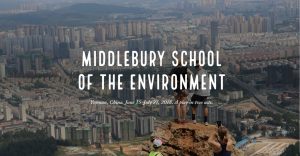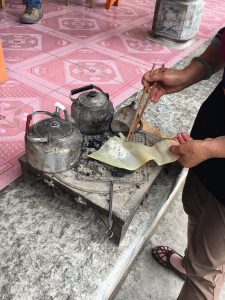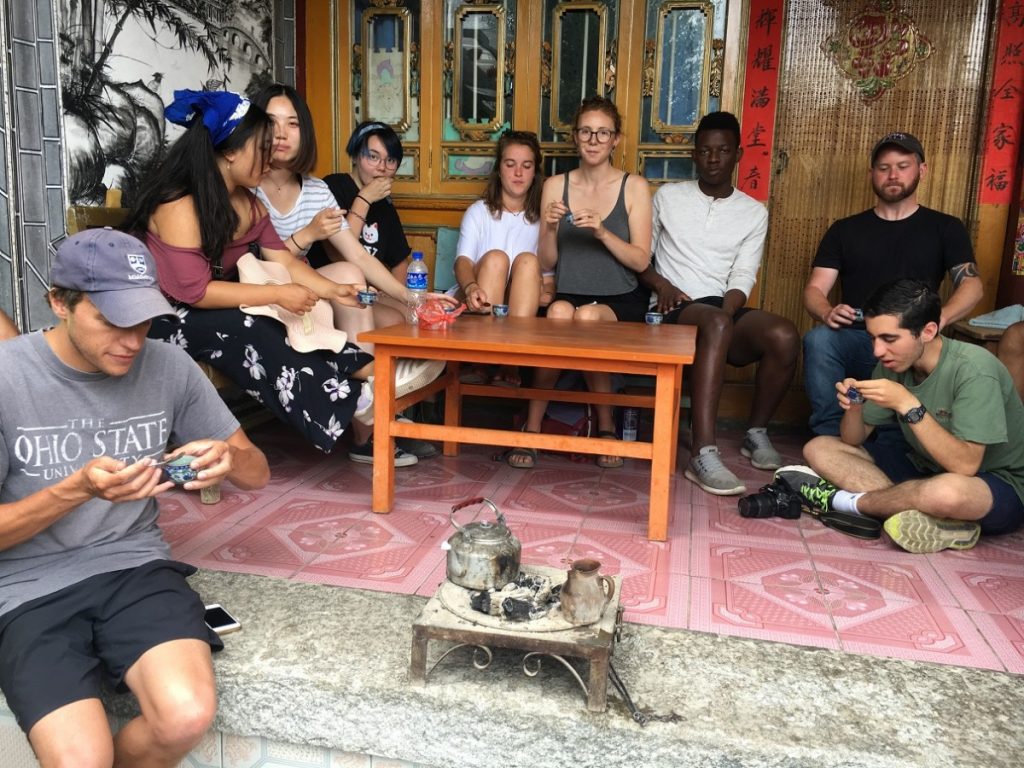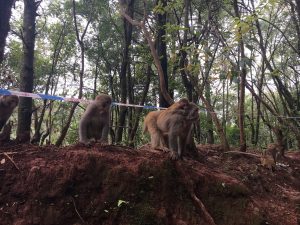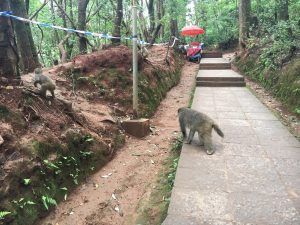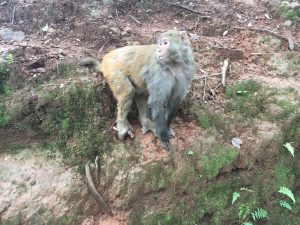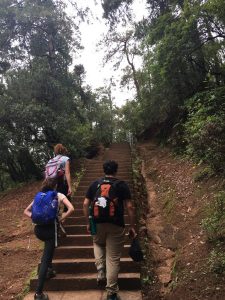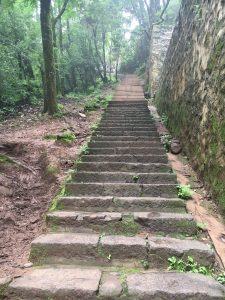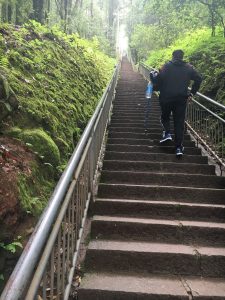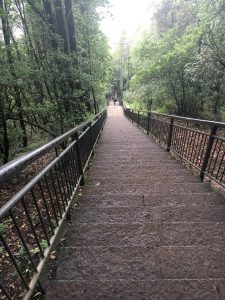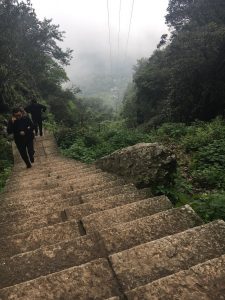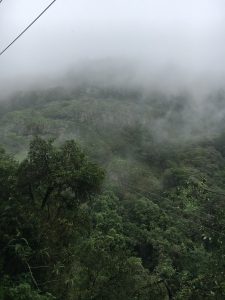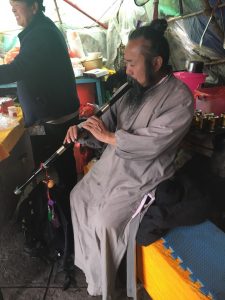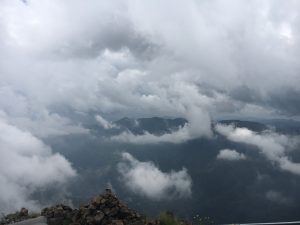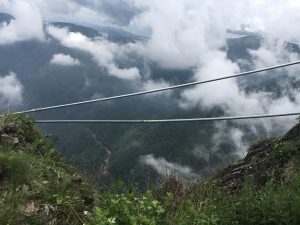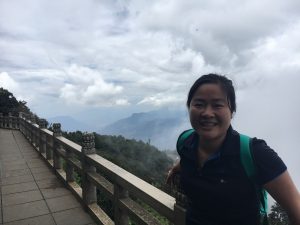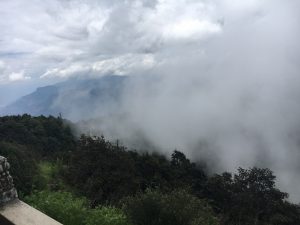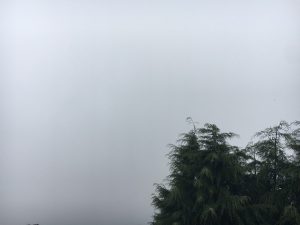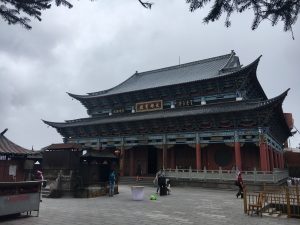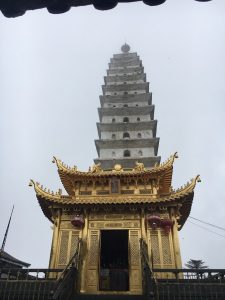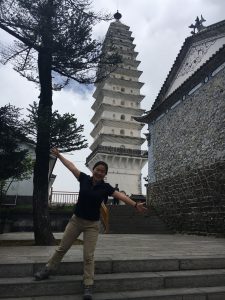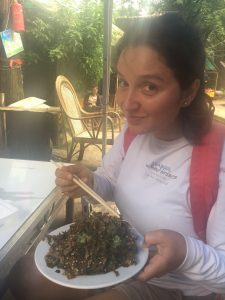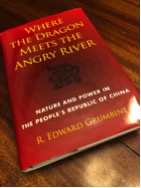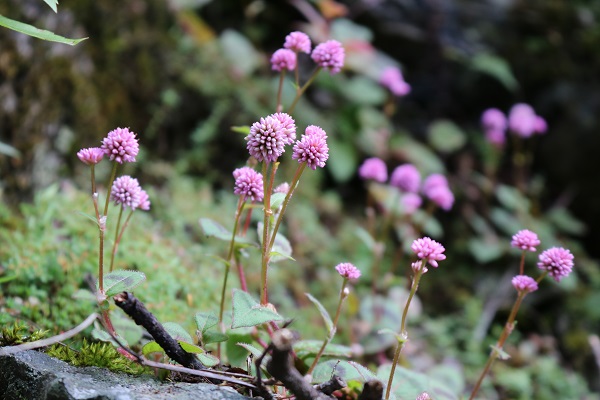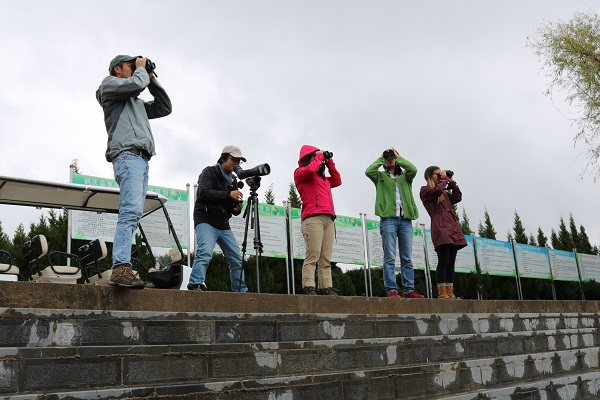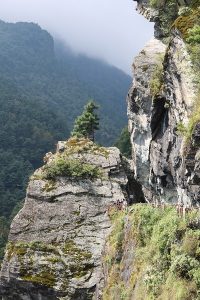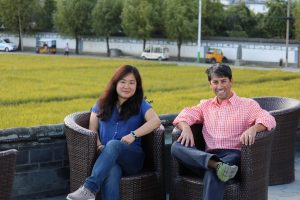Curt and I, as the Co-Directors of the Middlebury School of the Environment, are hosting monthly webinars to discuss about the transitions and transformations of environmental challenges. The first was done on Ocboter 31, 2018, in which I opened with a short presentation about China’s environmental challenges and some efforts that have been made by the government, local and international NGOs, and other practitioners. Curt followed with a walkthrough of the Adobe Spark page he created (see the post below, and here: https://spark.adobe.com/page/lCJCm3sXRAFaL/) to share our experience last summer. Hope you enjoy watch/read them:
Category: School of the Environment
A tip-to-toe summary of MSoE in 2018
Utilizing Adobe Spark, an interactive multimedia tool, we summarized on our summer 2018 in China and would love to share with you about this colorful experience. Click the link below, and scroll down to read our story.
A quick peek of MSoE in action in summer 2018
三道茶 (three-course tea): This is life.
After experiencing tie-dye, we went to a local Bai people’s house for lunch, who also served us their traditional three-course tea that represents different stages of life. In other words, “Bitterness, sweetness, and the aftertaste.”
The first course: bitterness. The tea server heats a small clay jar on charcoal, puts some tea leaves in and roasts them by turning the jar. Then she pours in boiled water and serves about half a cup of the tea to the guests. In the color of amber, the tea has a special burned smell and tastes bitter. It represents that you have to endure the bitterness of the first part of your life to achieve personal growth and a successful career that usually involves hard work and growing pains.
The second course: sweetness. After a similar process of heating the jar, roasting the tea leaves and serving with boiling water, the tea server adds brown sugar, diced Bai cheese, cinnamon, and sesame, etc. in the cup before pouring the tea. This aromatic sweetness is our reward for the hard work and achievements during the second stage of our life.
The third course: the aftertaste. The same procedure as the second course, but the ingredients in the cup is changed to honey, roast rice, numbing pepper, red pepper, and ginger. It’s served 60-70% full. Obviously, it offers all tastes for your tasting buds. It represents that during the last stage of your life, when you think back, all that life had for you come back with mixed long-lasting aftertaste and emotions.
Distilled from the wisdom of life that passed from generation to generation among the Bai people, three courses of tea cover all the stages of your life. It encourages you to be brave, to work harder, to embrace failure and disappointment, and to look forward to a brighter future. I feel that I could use some of this wisdom and encouragement from time to time in my life.
Apparently, there is a lot to think about when drinking this tea:
Above the clouds
Before yesterday, I would never have thought that I could have made it to a high elevation hike. Don’t get me wrong. I love hiking. The high elevation is what intimidates me. For months I’ve been saying no to hiking excursions unless I could carry oxygen tanks (plural) with me. Yak herders village deep in the mountains sounds cool. But oxygen sounds cooler.
Then yesterday came when I had to lead a group of students to hike the Jizu Mountain, of which I had no idea of the elevation. As a famous Buddhist sacred mountain, there are over 100 big or small temples dotted in it. There are also Taoist and local Benzhu temples. I thought it was just a short hike that even Eloise could handle and then a cable car ride to Jinding Temple at the top of the mountain. Easy peasy. So I didn’t even bring much snacks or water. After we got there after a two-hour drive, guess what, the cable car was closed for maintenance. Fine, we are on foot.
At first, it didn’t seem bad at all. 4720m (distance) seemed totally doable. We chatted and laughed while walking up, and said no to people who tried to convince us to get on a horse ride upward. Passed through some monkeys’ territory who seemed to have got used to tourists around. Even friendly.
Then flights and flights of steps showed up, I started to have a hard time getting enough air in my chest. Quickly I fell behind. And curiously, I checked the elevation – just under 7,000 feet. Not too bad – I kept telling myself while taking a break every now and then. UNTIL some seemingly forbidding steps came into sight. “How high is this thing?” The more I went up, the more I doubted if I could make it. But the more I climbed, the more I felt I’d regret if I didn’t go all the way up. While torn between this overwhelming self-doubt and a tiny hope for a personal breakthrough, I went up slowly but steady. At a certain point, I had to take a break every 50 steps. Along the way, I noticed the changes in vegetation. Part of it was almost like a rainforest. Everything was wet and slippery. It was a little hard to hold my feet on the stone passage. I felt I was completely surrounded by water.
I had to take a long break and get some snacks at one of the food tents along the way. This man makes THE BEST potatoes ever! It was so good that one of my students ate FOUR of them! We sat down and had a conversation with him, and learned that he lives at the foot of the mountain, and makes a 14km round trip everyday high up here to support two monks by cooking two meals for them. To be able to support them, he brings up and sells water and food to tourists like us. THIS, is what I call dedication. While we were enjoying the potatoes, an allegedly famous Taoist stopped by and said hi to everyone. Seeing so many people under the tent, he sat down, took out his 箫 and played some super refreshing music for us.
After the break at the tent, we were told that it would take another 50 minutes to get to Jinding temple. I was very close to giving up. But I saw everyone trying their best to keep going. Strangers say 加油!to me while passing by. Everyone was exhausted but with big smiles. Somehow, that kept me going and going. For maybe the last 10 minutes of the hike, I felt much better with my breaths and the hike actually started to become easier. I wonder if that was because my lungs got a little used to the oxygen level. I have to say that I looked miserable when I finally made it to the top. The trip took me 4 hours.
There at the top, the elevation was almost 11,000 feet. I was shocked when I saw the number. 4720m compounded by 4,000 feet elevation rise is actually pretty significant. I would never have done it if I knew it from the beginning because my mind would have given up already. In a certain sense, not knowing was actually helpful.
It was an amazing view at the top, standing above the clouds. Everything looked small, so was the world. Every bit of thoughts that bothered me didn’t seem to matter at that moment. The all white pagoda was quite different from all other pagodas I’ve seen before elsewhere. It felt quiet and tranquil. When I stood on the flat ground in the temple and looked around, there was not much but the clouds. At that moment I realized why the temples are always built on the top of the highest mountain and the monks seek seclusion for self-cultivation/meditation. When all you see is nothingness, the only way to look is inward.
Although today my legs felt like two chopsticks that don’t bend, this was the best experience I’ve ever had. Being above the clouds is an experience that won’t be forgotten.
Lastly, look at this kid who is totally obsessed with the lichens – what a reward after a long day of tough hike. Bravo, kids.
A Book Review
A book review by Dr. Curt Gervich, of R. Edward Grumbine’s Where the Dragon Meets the Angry River: nature and power in the People’s Republic of China (Island Press, 2010).
“When an untamed river encounters a dragon, what happens next?”
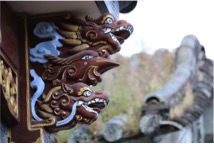
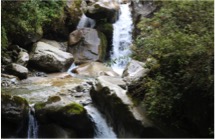
Caption: Dragons and Rivers in Yunnan Province, China.
That’s my favorite quote from R. Edward Grumbine’s Where the Dragon Meets the Angry River: nature and power in the People’s Republic of China (Island Press, 2010). The Angry River digs deep into the central questions that haunt conservation efforts in China and that form the central themes of the Middlebury School of the Environment’s curriculum in China. With years of experience in Yunnan, Grumbine explores topics such as how Yunnan is balancing the need for conservation with energy development; how rural communities in Yunnan are keeping pace with economic development in China while retaining rural character and culture; and how conservation efforts and policies can be effective in China against the backdrop of a wickedly complex bureaucratic governance structure that prioritizes economic development and centralized decision making above all else.
“China has never had a Henry David Thoreau, John Muir or Terry Tempest Williams. The country was shut off by the party from most international influences during the formative decades of the U.S. wilderness movement. Nature protection in China is rooted in a different soil.”
(Ed Grumbine, Where the Dragon Meets the Angry River: nature and power in the People’s Republic of China. Page 34.)
Not only does The Angry Dragon offer an in-depth perspective on environmental conservation in Yunnan Province, China– it also features many places students aboard the Middlebury School of the Environment may have the opportunity to experience in summer 2018. For example, Grumbine examines the urban development strategies of several communities in Yunnan, including Dali, Liejang and Kunming.
The Linden Centre, where MSoE is based when in Dali, is a 20 minute taxi ride from Dali’s historic old town. Here are some pictures of Dali’s historic centre from our recent planning trip:
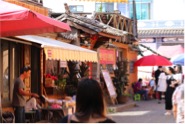

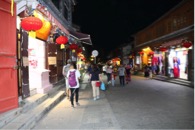
Caption: Day and night in Dali.
Liejang is about 120 minutes north west of Dali and also has a preserved old town, though it’s quite different from Dali. Kunming is about six hour south, and is home to six million people. It will be fun for students to experience the social-ecological systems of all three places.
In Angry River Grumbine details the role of The Nature Conservancy in biodiversity conservation in Yunnan. Middlebury School of the Environment is in the process of developing a multi-day conservation boot camp with The Nature Conservancy in Yunnan. This experience will take place at TNC’s migratory waterfowl and wetland conservation project at West Caohai. Our collaboration will focus on TNC’s conservation planning process from start to finish. It will include problem identification and scoping, data collection and analysis, education and policy development. Here’s the link to TNC’s China website.
And a few pictures of our trip to the West Caihai wetland site:
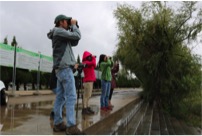

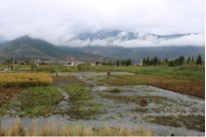
Caption: Middlebury and TNC staffers developing conservation boot camp at West Caohai.
Having returned from Yunnan in October and seen the sites and issues Grumbine details first hand, I have a few observations that I am excited to continue exploring with MSoE students in 2018. First, western China may be among the most under-appreciated and least well known biodiversity hotspots in the world. The eastern Himalayas contain an astounding array of ecosystems, rare and endemic species, and other gems. As Grumbine notes, the rivers that begin in this region drain an enormous percentage of Asia’s landmass, and are used by billions of people. That’s billions with a B. The geographic, social and economic scales of this place are of such a magnitude that they are difficult to comprehend. Second, Yunnan both reflects and rejects many of our assumptions about life in China, and the ways that social life is intertwined and dependent upon the environment. Finally, environmental professions and efforts in China are as varied and lively as anywhere. For example, environmental work in China is not only about biodiversity and energy– the functional areas we often hear about in the news. Environmental art, and sustainable food systems work are abundant and innovative. Here are some pics from a farm-to-table project we visited outside Dali:



Caption: Food systems innovations are as hot in Yunnan as in Middlebury Vermont. Farm-to-table experiments!
Environmental work is a grand experiment anywhere. It doesn’t matter if you’re in Vermont, on a college campus, or in China’s hinterlands. Yunnan province offers a new take on this experiment and is contributing to our growing body of knowledge in unique ways. Grumbine’s book has a lot to teach about conservation with Chinese characteristics.
R. Edward Grumbine is a professor of conservation biology at Prescott College. He also serves on the Middlebury School of the Environment advisory board.
Application for MSoE Summer 2018 is live!
The Middlebury School of the Environment (MSoE) begins a new chapter in Summer 2018, moving its successful six-week, living and learning pedagogy in environmental problem solving and leadership from Middlebury’s campus in Vermont to Yunnan province, China. Yunnan boasts rich biodiversity, historical legacy, cultural diversity, pressing environmental issues and emerging environmental solutions and leadership.
The MSoE pedagogy is problem-based. In this six-week program, students work alongside faculty and practitioners to tackle significant environmental problems that stretch beyond traditional disciplinary boundaries. This interdisciplinary approach is especially valuable considering the complexity of China’s environment. Our faculty represent fields as diverse as geology and chemistry, religious studies, geography, planning, filmmaking, and biodiversity conservation.
For students studying with MSoE in Yunnan, courses will occur in forests, wetlands and mountains; temples, kitchens, and homes; shops, alleys, and markets; laboratories, libraries and museums. Courses in the 2018 program include: Understanding Place, Sustainability Leadership Seminar, and Environmental Analysis.
Course Descriptions (students enroll in three, 300 level courses)
Understanding Place (3 credits)
Manifesting solutions to environmental challenges requires a deep understanding of “place,” by which we mean a sense of the history, culture, economy, and ecology of a location. Facing environmental challenges cannot be divorced from understanding either the people or the ecological realities of the location where the challenge is situated or from where the solution is to emerge. This is best understood by focusing first on a single place, and then examining that place in its global context. This course will explore a specific place through both ecological and cultural narratives (in other words, through geography, history, biology, literature, geology, and political science) to understand how this place came to be in the condition it is today; its global connections on multiple temporal and spatial scales; and how to improve conditions for both itself and the human communities associated with it.
Sustainability Leadership Seminar (3 credits)Governance and administration in China. Wicked problems. Sustainable communities. Spatial and systems thinking. Structured decision making. Persuasive communication. These are just a few of the topics this course will cover. Through a series of field-based exercises intended to hone your observational and analytical skills, and workshops from environmental leaders and practitioners based in the US and China, such as The Nature Conservancy, this course will enhance, amplify and elevate your sustainability leadership skills.
Environmental Analysis (3 credits)
Using a case study method, students in this course will use an interdisciplinary lens to explore critical environmental issues from both scientific and humanitarian perspectives. The class will explore pollution monitoring and management, and biodiversity conservation in the field and in the lab. Students will also learn the art of storytelling and filmmaking, while exploring the role of the arts in communicating about environmental problems and solutions, especially in a history and culture-rich local context. Students will come away from this course with a solid background in the physical and natural sciences, as well as appreciating the role of environmental ethics and arts in problem solving.
Please forward to interested students and faculty. The student application is here.
Visit the website for the Middlebury School of the Environment (http://www.middlebury.edu/environment) for more details about the program.
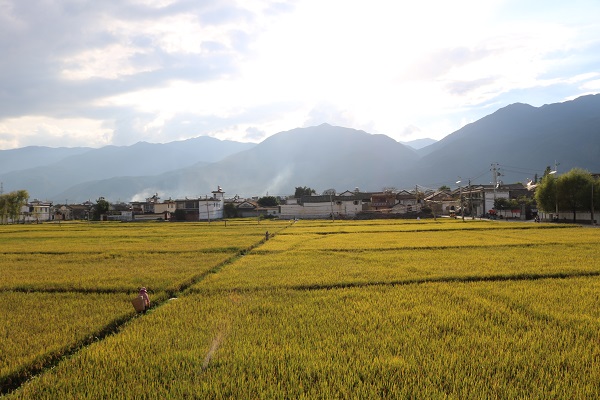
Meet the new directors of the MSoE!
The Middlebury School of the Environment (MSoE) begins a new chapter in Summer 2018. After four successful years developing its program in environmental learning and engagement on the main campus of Middlebury College in Vermont, we’re ready to launch the next step in our long-term development plan: developing an international dimension to its program.
This coming summer, the MSoE will be held in and around Kunming, China! The program will retain its traditional emphasis on interdisciplinarity, hands-on engagement, and leadership training. But now it will be focusing on the application of that emphasis in an international setting.
This represents a major leap forward for the MSoE, both in terms of its reach and its curricular focus. Much more can and will be written about the MSoE China curriculum in the coming weeks. But we want to first announce an important change in the program’s leadership.
A transition as momentous as the internationalization of the program and a move to China demands a transition in leadership that has expertise in the environmental issues and culture of China. We are extremely fortunate to have hired two environmental scholars as co-directors for the MSoE: Drs. Curt Gervich and Liou Xie, both on the faculty at the State University of New York (SUNY) at Plattsburgh.
Friends and alumni of the MSoE know Curt well, as he has been on the faculty of the MSoE since 2015, teaching both the Systems Thinking Practicum and Wicked Environmental Problems courses. He is an Associate Professor in the of the Center for Earth and Environmental Science at SUNY Plattsburgh where he teaches courses in environmental leadership, law and policy and sustainability, among others. Curt is trained as an environmental planner, with expertise in decision-making and leadership. His professional background includes developing habitat conservation plans in collaboration with the US Fish and Wildlife Service, training community involvement specialists at the Environmental Protection Agency in best practices for participatory planning, and serving as a researcher and planner for the International Joint Commission for Great Lakes Management’s Social, Political and Economics technical advisory group. His current research focuses on the use of games and simulations in professional and informal adult educational settings, environmental decision making and leadership in municipal policy networks; and best practices for experiential and applied learning environments. Curt has studied, lived, and worked across the United States and in Australia, Canada, China, and Mongolia.
Joining him as co-director is Liou Xie. Liou is an Assistant Professor of Geography and Environmental Studies at SUNY Plattsburgh where she teaches courses and conducts research in the fields of urban and economic geography, planning, sustainable transportation systems and communities, among other urban sustainability issues and solutions. Born and raised in China, she obtained her degrees from Beijing Normal University, the University of Hong Kong, and Arizona State University. Besides working in over a dozen cities in China, such as Beijing, Shanghai, Shenzhen, and Kunming, she applies her expertise in the local region by engaging in projects like writing comprehensive plans for Schuyler Falls, surveying service insufficiency and redevelopment potential around the Plattsburgh train station, and exploring employment challenges in the North Country. Liou is trained to use analytical and data visualization tools, such as GIS, CorelDraw, Photoshop and Sketchup in her research and teaching. She has several years of experience working with college students in international settings. She assisted a study abroad program at HKU which brought students to a rural area in Hunan province. She regularly takes her planning classes on a one-day field trip to Montreal. She teaches intensive courses on environmental management at a sister university in China.
We’re excited about what Liou and Curt will bring to the next phase of MSoE development, and we hope you’ll continue to check in on The Stream to read about what they have in store!!
The SoE heads to D.C.!
I’m excited to announce that we’re adding something new to the School of the Environment’s schedule for this summer. For one week during our six-week session, we will all be going down to Washington, D.C., to supplement our curriculum and leadership training program with visits with environmental leaders, organizations, and agencies to explore first-hand the strategies for … and challenges of … leading in a time of political change. In addition, we will engage closely with Frank Sesno and his team at Planet Forward, an organization based at George Washington University with the mission of moving the environmental narrative of the planet forward (hence the name) with evocative storytelling and communication.
Alumni from the MSoE’15 will remember Frank Sesno as our keynote speaker and one of our guest practitioners. He is currently the Director of The George Washington University School of Media and Public Affairs and the creator and host of Planet Forward. He was formerly CNN’s DC bureau chief, as well as anchor, interview host, and White House correspondent. He was the long-running host of CNN’s Sunday talk show Late Edition, and he remains a frequent guest host for CNN’s Reliable Sources.
Together with folks at Planet Forward, the MSoE faculty will help the students in this year’s program confront the question, “How can you lead in a time of change?” In fact, the political transitions we see in the U.S. today call upon all of us to recognize that leadership and strategies for environmental engagement must be responsive to dynamic political and cultural environments, and the question of how to lead in a time of change will frame our entire program this summer.
Our week in D.C. is included in the overall session and will not require any additional costs for the students. We will depart from Middlebury on Sunday, July 16th, and return on Saturday, July 22nd. This is the 4th week of our session, giving us plenty of opportunity to prepare in our classes beforehand and to follow-up with what we learned afterwards. We will be staying in the dorms at George Washington University’s Mt. Vernon campus, and we’ll take advantage of the facilities at the GW School of Media and Public Affairs as well as Middlebury College’s own office complex on K Street.
It is not an exaggeration to say that Washington, D.C., is one of the global capitals for environmental policy and engagement. The opportunity to integrate this experience with the traditional MSoE curriculum is amazing!
I’ll be posting more about this trip as details are confirmed. But I can guarantee that the week will be amazing!
Carbon neutrality at Middlebury College!
All MSoE alumni are aware that Middlebury College set for itself a goal of becoming carbon neutral by the end of 2016. The campus sustainability and renewable energy tours we include in the curriculum emphasize the initiatives that we launched in pursuit of that goal.
And you are all probably aware that we officially reached that goal with the certification of the carbon sequestration on our land that is now guaranteed through the creation of a permanent conservation easement on Bread Loaf land in the Green Mountains.
This is a big achievement, and there are so many narratives related to leadership and environmental engagement wrapped up in this overall story that it’s hard to know where to begin. First of all, the goal itself was the product of a student group who not only dreamed it up but conceived the college trustees to adopt the vision based on an equal mix of passion and a compelling plan for accomplishment. Never doubt that you — as individuals or as a small group — can bring about change.
Each step along the way, described quite well in a recent article written by Nathaniel Wiener for our friends at Planet Forward, was its own massive undertaking, involving technology (the biomass plant), educational outreach (energy efficiency), creative ideation on energy diversification and resiliency (solar and biomethane energy infrastructure), and land conservation and law (carbon sequestration on permanently conserved forestland). Each is a story all on its own (which I hope to describe in the future), but taken together indicates that large goals can be achieved through the combination of several smaller steps.
Now that carbon neutrality has been achieved here, the obvious question is “What comes next?” Carbon negativity? Local food systems engagement? Fossil fuel divestment? Zero fossil fuel use? The possibilities are great. And for any one of them, we know from experience that there is a path forward to success.
